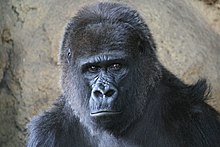Ueno Zoo
| Ueno Zoo | |
|---|---|
The Ueno Zoo (恩賜上野動物園, Onshi Ueno Dōbutsuen) is a 14.3-hectare (35-acre)
The zoo is in Ueno Park, a large urban park that is home to museums, a small amusement park, and other attractions. The zoo is closed on Mondays (Tuesday if Monday is a holiday).
History
The zoo started life as a menagerie attached to the National Museum of Natural History. In 1881, responsibility for this menagerie was handed to naturalist and civil servant Tanaka Yoshio, who oversaw its transition into a public zoo.[4] The ground was originally estate of the imperial family, but was bestowed (恩賜, onshi, forming the first part of the name in Japanese, untranslated officially) to the municipal government in 1924 — along with Ueno Park — on the occasion of crown prince Hirohito's wedding.[5]
World War II
In August 1943, the administrator of Tokyo, Shigeo Ōdachi, ordered that all "wild and dangerous animals" at the zoo be killed, claiming that bombs could hit the zoo and escaped animals would wreak havoc in the streets of Tokyo. Requests by the staff at the zoo for a reprieve, or to evacuate the animals elsewhere, were refused. The animals were executed primarily by poisoning, strangulation or by simply placing the animals on starvation diets. A memorial service was held for the animals in September 1943 (while two of the elephants were still starving) and a permanent memorial (built anew in 1975) can be found in the Ueno Zoo.[6]
Shortly after the March 1945 bombings of Tokyo, the Japanese placed U.S. Army Air Force navigator and bombardier Ray "Hap" Halloran on display naked in a Ueno Zoo tiger cage so civilians could walk in front of the cage and view the B-29 prisoner.[7][8]
Recent renovations
The zoo provides animals an environment similar to the natural habitat. In recent years, some of the old-fashioned cages of the past have been replaced with modern habitats, such as the "Gorilla Woods," built after two well-publicized mishaps in 1999.[9] Many of the animal's enclosures, such as that for the giraffe, hippopotamus, and rhinoceros are still the old style single stall concrete cages with very little room for the animals.
Animals


The zoo is home to more than 2,600 individuals representing over 500 species.[1]
Principal animals


After the death of
The zoo is split into two sections, connected by a bridge called the Aesop Bridge, built in 1961 and a monorail.
The eastern garden houses giant pandas,
The western garden houses
See also
- Faithful Elephants, story of the elephants in the zoo during World War II
- Tama Zoological Park
- Tokyo Sea Life Park
References
- ^ a b c d e "About Ueno Zoo". tokyo-zoo.net. Tokyo Zoological Park Society. Archived from the original on 17 April 2011. Retrieved 16 April 2011.
- ^ "Member's List/zoo". jazga.or.jp. JAZA. Retrieved 5 March 2011.
- ^ Baseel, Casey. "Japan's oldest monorail is permanently closing next month". SoraNews24. Retrieved 26 November 2023.
- ISBN 978-0-230-11744-0.
- ISBN 978-0-8493-2100-9
- ^ Starving the Elephants - The Slaughter of Animals in Wartime Tokyo's Ueno Zoo
- ^ War trauma leads to efforts to reconcile | The Japan Times Online Article dated Wednesday, April 30, 2008 (Retrieved on June 28, 2009)
- ^ The Autobiography of Raymond "Hap" Halloran
- ^ "The Controversy over the Value of Zoo Animals: Two Stories about Gorillas in a Japanese Zoo and What They Mean", Kawasaki Journal of Medical Welfare Vol. 6, No.1, 20007-12
- Japan Times, 2008
- ^ (in Japanese) The Ueno Pandas' Profiles, Ueno Zoo, 2011
- ^ (in Chinese) PRC Embassy in Japan, 大熊貓"比力、仙女"抵東京 Archived 2011-07-28 at the Wayback Machine (Giant Pandas Bili & Xiannü Arrived at Tokyo)
- ^ (in Japanese) ジャイアントパンダの名前が決まりました (Panda's Names Have Been Decided)
- ^ "Animals | Ueno Zoological Gardens".
Further reading
- Itoh, Mayumi (2010). Japanese Wartime Zoo Policy: The Silent Victims of World War II. Palgrave-MacMillan. ISBN 978-0230108943.
- Miller, Ian Jared (2013). The Nature of the Beasts: Empire and Exhibition at the Tokyo Imperial Zoo. University of California Press.
External links
![]() Media related to Ueno Zoo at Wikimedia Commons
Media related to Ueno Zoo at Wikimedia Commons

